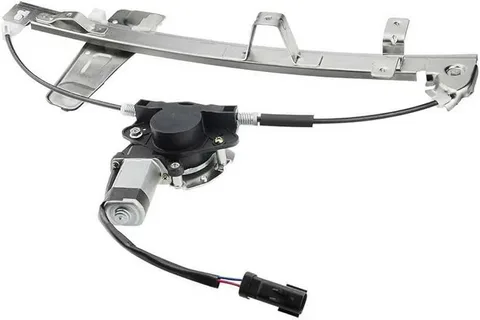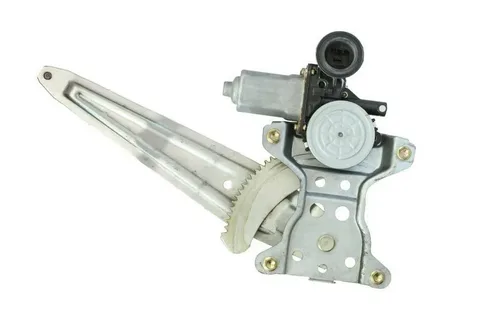Have you ever been stuck at a red light, desperately trying to roll down your window, only to hear the dreaded sound of silence? If so, you’re not alone. A malfunctioning window regulator can turn a simple drive into a frustrating ordeal. The good news is that replacing this essential Car Parts Window Regulator isn’t as daunting as it may seem. With just a few tools and some patience, you can restore functionality to your windows and save yourself from costly repairs at the mechanic.
Table of Contents
What Is a Window Regulator and Why It Needs Replacing
A window regulator is a crucial component of your car’s power windows. It controls the movement of the glass, allowing it to go up and down smoothly. It enables you to open or close your windows with just a button press.
Over time, window regulators can wear out due to constant use. The gears inside can break or become stripped, preventing them from functioning correctly. This often results in windows that will only move occasionally or intermittently.
Environmental factors also contribute to their deterioration. Over time, moisture and dirt can infiltrate the mechanism, leading to corrosion and rust buildup. These elements hinder performance and may cause parts to seize.
When it comes to replacing a faulty window regulator, it’s important not just for comfort but also for safety reasons. A malfunctioning regulator could leave your window stuck open during inclement weather or even fail while driving.
If you notice signs of struggle when operating your windows, addressing these issues promptly is essential. Ignoring them might lead to inconvenience and potential safety hazards as well.
Common Signs That Indicate a Faulty Window Regulator
A faulty window regulator might be the culprit if you’re experiencing issues with your car’s windows. One of the most common signs is inconsistent movement. If your window hesitates, struggles to go up or down, or gets stuck halfway, it’s time to investigate.
Another telltale sign is unusual noises. Listen for grinding, clicking, or popping sounds when operating the window. These sounds often indicate that parts within the regulator are wearing out or misaligned.
You may also notice that the window does not move at all. If pressing the switch yields no results—no sound, no movement—it could mean that the motor has failed or that there’s an issue with wiring in addition to potential problems in the regulator itself.
You might see visible damage on your door panel or glass alignment. Misalignment can lead to gaps where rain and wind can enter your vehicle interior.
Suppose you’ve had repeated repairs on your power windows recently but continue facing problems with them sticking or failing again soon after repair attempts. This pattern indicates it’s likely time for a replacement rather than more patchwork fixes.
 Tools and Equipment Needed for the Replacement your Car Door Window Regulator
Tools and Equipment Needed for the Replacement your Car Door Window Regulator
Having the right tools is essential when you decide to replace a Car Door Window Regulator. Start with basic hand tools like screwdrivers and pliers. A flathead screwdriver can help pry off trim panels, while Phillips-head screws secure most components.
Next, a ratchet set will come in handy for removing bolts that hold the window regulator in place. Ensure your set includes various socket sizes to fit different bolt types used in car parts.
Remember safety equipment! Safety goggles are crucial for any vehicle repair to protect your eyes from debris or accidental injuries. Wearing gloves can also prevent cuts and scrapes while handling sharp metal edges.
If you’re considering a DIY approach, take your time to research and gather all necessary information. Numerous online resources are available to guide you through each step.
Choosing between professional services and doing it yourself depends on your comfort level with car repairs. Weighing costs against personal skill sets will help in making an informed decision.
Regardless of your chosen route, ensuring proper installation is key for longevity. A correctly installed window regulator enhances overall vehicle performance while adding convenience to your daily driving experience.
A trim removal tool is another valuable addition to your toolkit. This specialized tool lets you remove plastic clips without damaging them, ensuring they can be reused later.
Consider having a work light or flashlight available for better visibility under the dashboard or inside the door panel. Proper lighting makes it easier to see what you’re doing and helps avoid mistakes during the replacement process.
Understanding the Types of Window Regulators
Understanding the various types of window regulators is crucial for a successful replacement. There are primarily two types: manual and power window regulators. Manual regulators operate through a hand crank mechanism, allowing you to roll the windows up or down using physical effort.
Power window regulators are more common in modern vehicles. They use an electric motor to raise or lower the windows automatically with a button push. This convenience often makes them preferable, but they can be more complex when repairs are needed.
These classifications have different designs, like scissor-type and cable-driven regulators. Scissor-type units have arms that fold in and out as the window moves, providing stability during operation. Meanwhile, cable-driven systems utilize cables connected to pulleys for smooth movement.
Each type has its own set of components and potential failure points. For example, power window motors may burn out, while manual cranks can become stripped over time. Knowing which system your vehicle uses simplifies troubleshooting and aids in effective replacements.
Choosing the right fit for your car involves identifying whether it’s manual or power and recognizing any unique features specific to your model year or manufacturer.
How to Choose the Right Auto Parts Window Regulator
Choosing the right Auto Parts Window Regulator can feel overwhelming, but it doesn’t have to be. Start by checking your vehicle’s manual or looking for specific details online. Knowing your car’s make, model, and year is crucial in ensuring compatibility with the new part.
Next, consider whether you need an OEM (Original Equipment Manufacturer) or an aftermarket part. The same manufacturer makes OEM parts as your original regulator. They offer a perfect fit and reliable performance but may carry a higher price tag. Aftermarket options can provide cost savings and often come with enhanced features.
Quality matters when selecting a window regulator. Do some research on different brands available in the market. Read reviews from other customers to gauge reliability and ease of installation.
Remember warranty coverage as well. A good warranty gives you peace of mind that you’re investing in quality car parts and window regulators.
Always double-check any return policies before making a purchase, just in case something goes wrong during installation or if the item doesn’t fit properly after all.
Professional vs. DIY Replacement: Which Option is Best?
The DIY Approach: Research and Preparation
If you’re leaning towards a DIY approach, start by researching thoroughly. Numerous online resources provide step-by-step guidance, making it easier to follow the process and ensure a successful installation.
Evaluating Your Comfort Level with Car Repairs
The choice between professional services and a DIY solution depends on your comfort level and experience with car repairs. Consider how confident you feel handling the task, as well as your familiarity with car components like window regulators.
Importance of Proper Installation
Regardless of whether you opt for a professional or DIY approach, proper installation is crucial. A well-installed window regulator not only boosts convenience but also enhances overall vehicle performance and durability.
Benefits of Professional Assistance
Hiring a professional mechanic can save time and reduce stress. Professionals come equipped with specialized tools, and many offer warranties on their work, providing peace of mind and ensuring quality results.
The Rewards of a DIY Project
Taking on the project yourself can be rewarding, providing hands-on experience and a deeper connection to your vehicle. With numerous tutorials available, even beginners may feel confident enough to attempt this repair on their own.
Assessing Skill Level and Potential Risks of DIY
It’s essential to assess your skill level honestly before beginning a DIY replacement. Mistakes during installation could lead to further damage or additional costs. If you’re uncertain about any steps, seeking professional help might be the better choice.
Weighing Costs, Skills, and Urgency in Your Decision
Deciding between professional help and DIY requires balancing costs, personal skills, and urgency. Considering these factors will help you make an informed decision that best suits your needs and capabilities.
The Cost of Replacing a Window Regulator Motor Assembly
Replacing a Window Regulator Motor Assembly can vary significantly in cost depending on several factors. The price of the part itself is usually between $50 and $300. This range largely depends on your vehicle’s make and model and whether you’re opting for an original equipment manufacturer (OEM) part or an aftermarket option.
Labour costs also play a crucial role if you have the work done by a professional mechanic. On average, labour can add another $75 to $150 to your total bill. Some shops charge hourly rates, while others might offer flat fees based on specific services.
If you’re handy with tools, doing it yourself can save you a lot of money. You’ll need to invest in basic tools and possibly watch tutorial videos online for guidance.
Keep in mind that additional expenses may arise during the replacement process. For example, if there are any electrical issues or damage to other components, those could incur extra costs.
Always consider obtaining quotes from different repair shops before making a decision. Comparing prices will help ensure you get the best deal available for your car parts window regulator replacement.
Conclusion
Replacing a window regulator can be rewarding. With the right knowledge and tools, you can efficiently restore the functionality of your car’s windows.
Understanding the components involved makes the process smoother. This ensures that you’re well-prepared for any challenges that may arise during the replacement.
FAQs
What is a window regulator?
A window regulator is a mechanical component that controls the movement of your car’s windows. It allows them to go up and down smoothly. If it’s malfunctioning, you’ll notice difficulty operating your windows.
How do I know if my window regulator needs replacement?
Common signs include unusual noises when operating the window, windows getting stuck mid-way, or not moving. If you experience any of these issues, it’s wise to investigate further.
Can I replace a window regulator myself?
Yes! With the right tools and guidance, many people complete this task independently. However, if you’re uncomfortable with DIY repairs or need more experience with car parts like the window regulator, seeking professional help may be better.
What tools will I need for installation?
Generally speaking, basic hand tools such as screwdrivers (both Phillips and flathead), pliers, and socket wrenches, along with safety glasses, should suffice for most installations.
| Related Business Listings |
| Contact Directory |
| Local Business Profiles |



